Josaphat Kuntsevych
Josaphat Kuntsevych, O.S.B.M., (c. 1580 – 12 November 1623) (Polish: Jozafat Kuncewicz, Lithuanian: Juozapatas Kuncevičius, Ukrainian: Йосафат Кунцевич, Josafat Kuntsevych) was a Polish-Lithuanian monk and archeparch (archbishop) of the Ruthenian Catholic Church, who on 12 November 1623 was killed by an angry mob in Vitebsk,[lower-alpha 1] Vitebsk Voivodeship, in the Polish-Lithuanian Commonwealth (present day Belarus). He is "the best-known victim" of anti-Catholic violence related to implementing the Union of Brest,[4](p57)[5] and is declared a martyr and saint of the Catholic Church.[lower-alpha 2]
Saint Josaphat Kuntsevych O.S.B.M. | |
|---|---|
| Archeparch of Polotsk | |
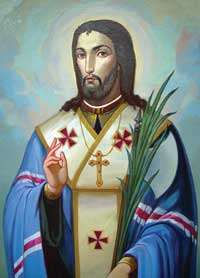 | |
| Church | Ruthenian Catholic Church (present-day Ukrainian Catholic Church) |
| Diocese | Archeparchy of Polotsk |
| Appointed | 1618 |
| Term ended | November 12, 1623 |
| Predecessor | Gedeon Brolnicki |
| Successor | Antonius Sielava |
| Personal details | |
| Birth name | Ivan Kunchych[1] |
| Born | c. 1580 Volodymyr, Volhynian Voivodeship, Polish–Lithuanian Commonwealth |
| Died | November 12, 1623 Vitebsk, Vitebsk Voivodeship, Polish-Lithuanian Commonwealth |
| Sainthood | |
| Feast day | November 12 (Latin Church, Belarusian Greek Catholic Church, Romanian Greek Catholic Church, Ruthenian Catholic Church[2]) November 14 (General Roman Calendar of 1960) November 25 (Ukrainian Greek Catholic Church) |
| Title as Saint | Bishop and martyr |
| Beatified | May 16, 1643 Rome by Pope Urban VIII |
| Canonized | June 29, 1867 Rome by Pope Pius IX |
| Patronage | Ukraine |
Ordination history of Josaphat Kuntsevych | |||||||||||
|---|---|---|---|---|---|---|---|---|---|---|---|
| |||||||||||
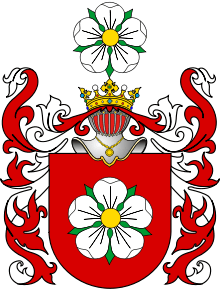
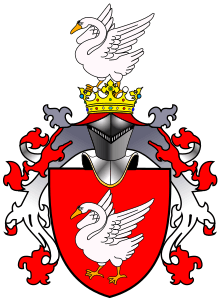
His death reflects the conflict among Christian Orthodox and Catholics that had intensified after the Ruthenian Orthodox Church (Kiev Metropolitanate) confirmed its communion with the Roman Catholic Church through the 1596 Union of Brest.
Life
Historical and religious background
King Sigismund III Vasa's policy for the Counter-Reformation in the Polish–Lithuanian Commonwealth was to reunite, "through missions to non-Catholics, both Protestant and Orthodox," all Christians into the Roman Catholic Church.[7](pp302–303) After preliminary negotiations with Sigismund III and with Grand Chancellor and Great Hetman of the Crown Jan Zamoyski, a delegation of bishops from the Eastern Orthodox Metropolitanate of Kiev (1458–1596) was sent to Rome in 1595 to accede to the Union of Florence on condition that their rituals and discipline were left intact.[8](pp202–203) Most Eastern Orthodox bishops within the Commonwealth, including Michael Rohoza, metropolitan of Kiev – but at Vilnius,[lower-alpha 3] Vilnius Voivodeship, the capital city of the Grand Duchy of Lithuania, in the Polish–Lithuanian Commonwealth – were signatories of the Union of Brest in 1596 which brought the Metropolitanate of Kiev into communion with the Roman Catholic Church. Two ecclesiastical factions, those Eastern Orthodox bishops who were signatories and those Eastern Orthodox bishops who were not signatories, met and excommunicated each other, but those who did not assent were in a much worse position than before, because they were no longer officially recognized.[8](p204) The Union resulted in two sectarian groups:
- Eastern Orthodox adherents who did assent to the Union of Brest articles became Eastern Catholic and were known as "Uniates", or "unici" in Polish.[9](p174)[lower-alpha 4] They were considered as "schismatics and traitors" by the Orthodox Church.[10](p69)[lower-alpha 5] "About two-thirds of the Ruthenian population" were Uniates by 1620.[11](p88) The northeastern voivodeships became predominantly Uniate.[3](p42)[12](p42)
- Eastern Orthodox adherents who did not assent to the Union of Brest articles remained Eastern Orthodox and were known as "Disuniates", or "dysunici" in Polish; they were considered religious dissidents by the government.[9](p174)[lower-alpha 6] The southeastern voivodeships became predominantly Disuniate.[3](p42)[12](p42) Disuniates were subjected to varying degrees of religious persecution by the state with the active support of Uniate and Latin Rite Catholic clergy.[10](pp95–97) The Disuniates were leaderless until a reestablished Eastern Orthodox Metropolitanate of Kiev (1620–1685) hierarchy was consecrated in 1620, which the government legalized in 1632.[5]
Early life
He was born Ioann Kuntsevych in 1580 or 1584 in Volodymyr,[lower-alpha 7] Volhynian Voivodeship, in the Lesser Poland Province of the Polish Crown (now in Ukraine). He was baptized into a family associated with the Eastern Orthodox Church.
Although descended from Ruthenian nobility (szlachta, Kuncewicz family), his father had embarked in business, and held the office of town-councilor. Both of Kuntsevych's parents encouraged religious participation and Christian piety in the young John. In the school at Volodymyr he gave evidence of unusual talent; he studied Church Slavonic and memorized most of the Horologion, which from this period he began to read daily. From this source he drew his early religious education.[lower-alpha 8]
Owing to his parents' poverty, Kuntsevych was apprenticed to a merchant named Papovič in Vilnius. In Vilnius, divided through the contentions of the various religious sects, he became acquainted with men such as Josyf Veliamyn Rutsky, a Calvinist convert to the Latin Church who transferred to the Byzantine Rite. Rutsky supported the recent union with Rome, and under his influence Kuntsevych grew interested in the Catholic Church.
Monk and archbishop
In 1604, in his early 20s, Kuntsevych entered the Monastery of the Trinity (Church and monastery of Holy Trinity) of the Order of Saint Basil the Great in Vilnius, at which time he was given the religious name of Josaphat. Stories of his sanctity rapidly spread and distinguished people began to visit the young monk. After a notable life as a layman, Rutsky also joined the Order. When Josaphat was ordained to the diaconate, his regular services and labor for the Church had already begun. As a result of his efforts, the number of novices to the Order steadily increased, and under Rutsky – who had meanwhile been ordained a priest – a revival of Eastern Catholic monastic life began among the Ruthenians (Belarusians and Ukrainians).[13][14] In 1609, after private study under Jesuit Valentin Groza Fabricy, Josaphat was ordained a priest by a Catholic bishop. He subsequently became the hegumen (prior) of several monasteries. On November 12, 1617, he was consecrated as the coadjutor archeparch for the Archeparchy of Polotsk.[lower-alpha 9] He succeeded as archeparch in March 1618.[15] During his episcopacy, the Saint Sophia Cathedral in Polotsk was rebuilt in 1618–1620.
Kuntsevych faced a daunting task of bringing the local populace to accept union with Rome. He faced stiff opposition from the monks, who feared liturgical Latinisation of the Byzantine Rite. As archeparch he: restored the churches: issued a catechism to the clergy, with instructions that it should be memorized; composed rules for priestly life, and entrusted deacons the task of superintending their observance; assembled synods in various towns in the dioceses; and firmly opposed the Grand Chancellor of the Grand Duchy of Lithuania, Lew Sapieha, who wished to make what Josaphat saw as too many concessions to the Eastern Orthodox. Throughout all his strivings and all his occupations, he continued his religious devotion as a monk, and never abated his desire for mortification of the flesh. Through all this he was successful in winning over a large portion of the people.[16]
Discontent increased among the inhabitants of the eastern voivodeships. In 1618 Disuniate at Mohilev[lower-alpha 10] Vitebsk Voivodeship, who apparently assented to the Union of Brest, openly resisted its implementation and replaced Uniate clergy with Disuniate clergy. They substituted the names of Timothy II, patriarch of Constantinople, and Osman II, sultan of the Ottoman Empire, in the Liturgy for those of Pope Paul V and Sigismund III.[lower-alpha 11] The resistance at Mohilev led to increased government intervention against Disuniates, and a 1619 judicial decree condemned the leaders of the insurrection to death and devolved all the previously Eastern Orthodox church buildings at Mohilev to the Eastern Catholic Archeparchy of Polotsk.[17](pp190–191)[lower-alpha 12]
Norman Davies wrote, in God's Playground, that Kuntsevych "was no man of peace, and had been involved in all manner of oppressions, including that most offensive of petty persecutions – the refusal to allow the Orthodox peasants to bury their dead in consecrated ground;"[9](pp174–175) in other words, he prohibited burial of Disuniates in Uniate cemeteries.[3](p42)
The Disuniates did not collapse. In 1620 they assembled in synod at Kiev, protected by Petro Konashevych-Sahaidachny, hetman of Zaporizhian Cossacks, and elected new Eastern Orthodox bishops including Meletius Smotrytsky as archbishop-elect of Polotsk, all of whom were consecrated "in great secrecy" at Kiev by Theophanes III, Greek Orthodox Patriarch of Jerusalem, Neophyte, metropolitan of Sofia, and Avramios, bishop of Stagoi. Thus a rival Disuniate hierarchy was established.[7](p305)[11](p90)[17](p191) Sigismund III accused Theophanes III of being a covert agent working on behalf of the Ottoman Empire and ordered his arrest and arrest of those consecrated by him.[11](pp89–90)
That changed in 1620, when, with Cossack aid, a rival Eastern Orthodox hierarchy was set up by the Orthodox Church,[5][19] with Smotrytsky (who later himself entered into communion with the see of Rome)[20][21] being appointed the Orthodox Archeparch of Polotsk.[5]
Smotrytsky publicly claimed that Kuntsevych was preparing a total Latinization of the Church and its rituals.[16]
After 1620, according to Orest Subtelny, in Ukraine, sectarian violence over ownership of church property increased and "hundreds of clerics on both sides died in confrontations that often took the form of pitched battles."[5]
The government imposed a settlement on the "unsettling and destructive" conflict in 1632 by legalizing the Disuniate hierarchy and redistributing church property between Uniates and Disuniates.[5][lower-alpha 13]
Death
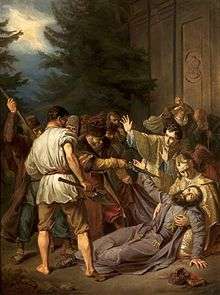
John Szlupas wrote, in The Princeton Theological Review, that the Lithuanian Protestants were also the secret instigators in the murder of Kuntsevych, and Smotrytsky, the chief agent in the murder, was in constant communication with them.[22](pp263)
In October 1623 Kuntsevych ordered the arrest of the last priest who was clandestinely holding Orthodox services at Vitebsk,[21] where Kuntsevych had a residence.[23] Enraged at this, some Orthodox townspeople lynched Kuntsevych on 12 November.[21][24] Witnesses of the event described it as follows:
The ringing of cathedral bells and the bells of other churches spread. This was the signal and call to insurrection. From all sides of town masses of people – men, women, and children – gathered with stones and attacked the archbishop's residence. The masses attacked and injured the servants and assistants of the archbishop, and broke into the room where he was alone. One hit him on the head with a stick, another split it with an axe, and when Kuntsevych fell, they started beating him. They looted his house, dragged his body to the plaza, cursed him – even women and children. ...They dragged him naked through the streets of the city all the way to the hill overlooking the river Dvina. Finally, after tying stones to the dead body, they threw him into the Dvina at its deepest.[25](p121)[23]
In January 1624, a commission presided over by Sapieha investigated Kuntsevych's murder and sentenced 93 people to death for their involvement in the conspiracy,[4](pp57)[lower-alpha 14] and many were banished and their property confiscated. The townhall and the disuniate churches were destroyed, and the franchises of the city abolished, but restored under the subsequent reign.[17](pp193–194) With Kuntsevych's death the Disuniates were completely broken up in Lithuania, and their leaders were severely punished. The Disuniates lost their churches in Vitebsk, Polotsk, Orsza, Mogilev, and other places. Smotrytsky joined the Uniates in order to escape punishment, and turned his pen against the Disuniates whose weaknesses were not secrets from him.[22](pp263) The body was recovered from the river and lay in state in the cathedral of Polatsk. Beatification followed in 1643, but canonization did not take place until 1867, more than two centuries later.[19] The body is now in Saint Peter's Basilica in Rome, placed under the altar of Saint Basil the Great.[16]
Legacy
Hagiography
As a boy Kuntsevych was said to have shunned the usual games of childhood, prayed much, and lost no opportunity to assist at the Church services. Children especially regarded him with affection. As an apprentice, he devoted every leisure hour to prayer and study. At first Papovič viewed this behavior with displeasure, but Josaphat gradually won such a position in his esteem that Papovič offered him his entire fortune and his daughter's hand. But Josaphat's love for the religious life never wavered.
Kuntsevych's favourite devotional exercise was the traditional Eastern monastic practice of prostrations, in which the head touches the ground, while saying the Jesus Prayer. Never eating meat, he fasted much, wore a hair shirt and a chain around his waist. He slept on the bare floor, and chastised his body until the blood flowed. The Jesuits frequently urged him to set some bounds to his austerities.
From Kuntsevych's zealous study of the Church Slavonic Byzantine Rite liturgical books he drew many proofs of Catholic doctrine and wrote several original works.[lower-alpha 15] Throughout his adult life, he was distinguished by his extraordinary zeal in performing the Church services and by extraordinary devotion during the Divine Liturgy. Not only in the church did he preach and hear confessions, but likewise in the fields, hospitals, prisons, and even on his personal journeys. This zeal, united with his kindness for the poor, led great numbers of Eastern Orthodox confession Ruthenians to a religious conversion to the Eastern Catholic confession and Catholic unity. Among his converts were many important personages such as deposed Patriarch Ignatius, of Moscow, and Manuel Kantakouzenos, who belonged to the imperial family of the Byzantine Emperor Palaeologus.
Canonization
Saint Josaphat O.S.B.M. | |
|---|---|
 | |
| Archeparch of Polotsk | |
| Born | Josaphat Kuntsevych Ivan Kunchych[1] c. 1580 Volodymyr, Volhynian Voivodeship, Polish–Lithuanian Commonwealth |
| Died | November 12, 1623 Vitebsk, Vitebsk Voivodeship, Polish-Lithuanian Commonwealth |
| Venerated in | Catholic Church (Ukrainian Greek Catholic Church) |
| Feast | November 12 (Latin Church, Romanian Greek Catholic Church, Ruthenian Catholic Church[2]) November 14 (General Roman Calendar of 1960) November 25 (Ukrainian Greek Catholic Church) |
| Patronage | Ukraine |
After numerous miracles attributed to Kuntsevych were reported to Church officials, Pope Urban VIII appointed a commission, in 1628, to inquire into his possible canonization, which examined 116 witnesses under oath. Josaphat's body was claimed to be incorrupt five years after his death. In 1637, a second commission investigated his life and, in 1643, Josaphat was beatified. He was canonized on June 29, 1867, by Pope Pius IX.[26] The Ukrainian Greek Catholic Church celebrates his feast day on the first Sunday after the Julian Calendar November 12 (Gregorian Calendar November 25). When, in 1867, Pius IX inserted his feast into the General Roman Calendar, it was assigned to November 14, which was the first free day after November 12, which was then occupied by the feast of "Saint Martin I, Pope and Martyr." In the General Roman Calendar of 1969, this latter feast was moved to Pope Saint Martin's dies natalis (birthday to heaven), and Saint Josaphat's feast was moved to that date, his own dies natalis.[27] Some Traditionalist Catholics continue to observe the General Roman Calendar of 1954, the General Roman Calendar of Pope Pius XII, or the General Roman Calendar of 1960, in which the feast day is on November 12.
Kuntsevych's canonization process began in the interval of the January Uprising of 1863–1865 against the Russian Empire and was "understood in many circles, including Polish, Russian, and Ruthenian circles, as a papal gesture of moral support for the insurgent Poles."[19](p31) A Russophile Ruthenian newspaper, Slovo, published several negative articles about Kuntsevych.[19](pp29–30)[lower-alpha 16] This antagonism to his canonization "makes sense within the context of the Russophile hegemony in Ruthenian public opinion" and was seen as an insult to Imperial Russia.[19](p31) The Russian government responded, in 1875, with further Russification and forced conversion of the Eastern Catholic Chełm Eparchy, the last Eastern Catholic eparchy in the Russian Empire.[19](p32)
Veneration
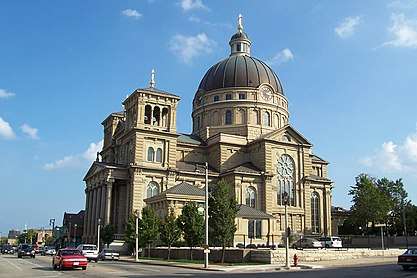
According to The Oxford Dictionary of Saints, Kuntsevych could be thought of as a patron "of ecumenical endeavour today."[30]
- Churches
St. Josaphat Kuntsevych is the patron saint of a number of Polish and Ukrainian churches and parishes in the United States and Canada including:
- Basilica of St. Josaphat, in Milwaukee, Wisconsin
- St. Josaphat Ukrainian Catholic Cathedral of the Ukrainian Catholic Eparchy of Saint Josaphat in Parma, Ohio.
- St. Josaphat Roman Catholic Church in Chicago, Illinois
- St. Josaphat's Parish of Bayside, Queens, New York
- St. Josaphat's Ukrainian Catholic Church in Rochester, NY
- St. Josaphat's Roman Catholic Church in Detroit
- St. Josaphat Parish in Cheektowaga, New York, in the Roman Catholic Diocese of Buffalo
- St. Josaphat's Cathedral and Ukrainian elementary school in Toronto
- St. Josaphat Ukrainian Catholic Cathedral in the Ukrainian Catholic Eparchy of Edmonton, Alberta
- St. Josaphat Ukrainian Catholic Church of Trenton, NJ
- Society of St. Josaphat
A group of Ukrainian Catholics, who oppose the changes made in the Ruthenian Rite to reduce Roman influence, have formed the Priestly Society of Saint Josaphat. They are linked to the Society of St. Pius X which has not recognized the authority of the Second Vatican Council.
- Relic
There is a relic of the saint in the "catacombs" of Holy Trinity Roman Catholic Church in Chicago.
See also
- Blessed Josaphata Hordashevska - Foundress of the Sisters Servants of Mary Immaculate and missionary under patronage of St. Josaphat
- List of Catholic saints
- Saint Josaphat Kuntsevych, patron saint archive
Notes
- Vitebsk was an important town built at a portage between the Daugava River and Dnieper River along the trade route from the Varangians to the Greeks.[3](p7) It was granted Magdeburg rights in 1597. Those Magdeburg rights were divested from Vitebsk in 1624 as a punishment for Kuntsevych's murder.[4](p57)
- "Polemical assessments still dominate the church literature" about Kuntsevych. According to the Religious Information Service of Ukraine at Ukrainian Catholic University, "the circumstances of his life and his murder have been heavily researched and are devoid of religious myths" but "known only by a narrow circle of scholars."[6]
- Vilnius was granted Magdeburg rights in 1387.
- "Greek Catholic Confession of the Slavonic Rite".[9](p174)
- The conflict between the two sectarian groups "has lasted into the 21st century."[10](p69)
- "Greek Orthodox Confession of the Slavonic Rite".[9](p174)
- Volodymyr was granted Magdeburg rights in 1431.
- The "flagrant and manifold abuses" in the Eastern Orthodox Church within the Commonwealth, seemed according to Bain, "to justify the necessity of its union with the better-ordered and instructed Roman Church. All contemporary evidence describes its condition in the darkest colours. The bishops, with scarce an exception, were robbers and ruffians; the lesser clergy followed the unedifying example of their ecclesiastical superiors. Konstanty Ostrogski, voivode of Kiev, the chief pillar of the Orthodox church, bitterly complained that the common people hungered in vain for the word of God," and Smotrytsky "declared that he could not lay his hand on three Orthodox preachers, and that, but for the aid of Catholic postils, there would have been no preaching at all." An attempt by Jeremias II of Constantinople, in 1588, "to reform these abuses only made matters worse and raised a storm of protest."[8](pp202–203)
- Polotsk was an important town built at a junction of key trade routes from northern Europe to Constantinople.[3](pp5–6) It was granted Magdeburg rights in 1498.
- Mohilev was granted Magdeburg rights by Stephen Báthory in 1577.
- Walerian Krasiński believed this demonstrated "what a strong feeling must have existed" against the Tsardom of Russia: when oppressed on account of their religion, they turned to the distant Islamic Ottoman Empire rather than the nearby Eastern Orthodox Tsardom of Russia.[17](p190)
- Bohdan Sobol, the father of Spiridon Sobol, was among the executed people.[18]
- Bain noted that, c. 1632, the nobles and clergy owned most of the land in the Kingdom; the clergy owned 160,000 villages out of a total of 215,000, and paid no taxes at all.[8](p196)
- According to Kempa, 74 of the 93 people sentenced to death were sentenced in absentia.[4](pp57)
- On the Baptism of St. Volodymyr. On the Falsification of the Slavic Books by the Enemies of the Metropolitan. On Monks and their Vows.
- For example, portions of a 1622 letter from Sapieha to Kuntsevych were published by Slovo. According to Himka, "Slovo was insinuating by publishing this letter that" Kuntsevych was not a martyr but was murdered "as a natural consequence of his own violent actions." The canonization was used to "shape and reinforce" the emotional character about "a key Russophile argument" – that an Eastern Catholic Church was not beneficial to Ruthenians.[19](pp29–31) Krasiński included only an English translation of an extraction from the Sapieha letter.[17](pp192–193) While Alphonse Guépin included a French translation of the entire Sapieha letter and the entire Kuntsevych response to Sapieha.[28](pièces justificatives) Neither letter was included in an abridged Polish translation of Guépin by Walerian Kalinka.[29]
References
- Sas, P. Ivan (Kunchych) Kuntsevych. Encyclopedia of History of Ukraine.
- "Calendar of Saints (MCI)". mci.archpitt.org.
- Wilson, Andrew (2011). Belarus : the last European dictatorship. New Haven: Yale University Press. ISBN 9780300134353.
- Kempa, Tomasz (2010). "Religious relations and the issue of religious tolerance in Poland and Lithuania in the 16th and 17th century" (PDF). Sarmatia Europaea. Wrocław ?: Instytut Historyczny Uniwersytetu Wrocławskiego ?. pp. 31–66. ISSN 2082-5072. Archived (PDF) from the original on 2014-12-02. Retrieved 2014-12-02.
- Subtelny, Orest (2009). Ukraine: a history (4th ed.). Toronto [u.a.]: University of Toronto Press. ISBN 978-1-44269728-7.
- "Ukrainian Greek Catholic Church". Religious Information Service of Ukraine. Lviv: Institute of Religion and Society of the Ukrainian Catholic University. 2011-08-15. Archived from the original on 2013-03-20.
- Crummey, Robert O. (2006). "Eastern Orthodoxy in Russia and Ukraine in the age of counter-Reformation". In Angold, Michael (ed.). Eastern Christianity. The Cambridge history of Christianity. 5. Cambridge: Cambridge University Press. pp. 302–324. doi:10.1017/CHOL9780521811132.014. ISBN 9780521811132 – via Cambridge Histories Online.
-

- Davies, Norman (1982). God's playground : a history of Poland. 1. New York: Columbia University Press. pp. 174–175. ISBN 0-231-05350-9.
- Sužiedėlis, Saulius (7 February 2011). Historical dictionary of Lithuania. Historical dictionaries of Europe. 80 (2nd ed.). Lanham, MD: Scarecrow. ISBN 978-0-8108-4914-3 https://books.google.com/books?id=VkGB1CSfIlEC&pg=PA69. Missing or empty
|title=(help) - Medlin, William K.; Patrinelis, Christos G. (1971). Renaissance influences and religious reforms in Russia : Western and post-Byzantine impacts on culture and education (16th-17th centuries). Études de philologie et d'histoire. 18. Genève: Librairie Droz. ISBN 9782600038942.
- Skinner, Barbara (2009). The western front of the Eastern Church: Uniate and Orthodox conflict in 18th-Century Poland, Ukraine, Belarus and Russia. DeKalb, IL: Northern Illinois University Press. ISBN 9780875804071.
- "Seliava, Antonii Atanasii". www.encyclopediaofukraine.com.
- "Vilnius". www.encyclopediaofukraine.com.
- "Archbishop St. Jozafat Kuncewicz, O.S.B.M." Catholic Hierarchy. Retrieved November 12, 2012.
- "St. Josaphat". AmericanCatholic.org. Retrieved November 12, 2012.
-

- Makarīĭ, Metropolitan of Moscow. "Борьба православия с унией при митрополите Велямине Рутском" [The struggle of Orthodoxy with the Unia under Metropolitan Velyamine Rutsky]. История Русской Церкви [History of the Russian Church] (in Russian). 5.
- Himka, John-Paul (1999). "The canonization of Iosafat Kuntsevych and its reception in Galicia". Religion and nationality in western Ukraine : the Greek Catholic Church and the Ruthenian National Movement in Galicia, 1867-1900. McGill-Queen's studies in the history of religion. Montreal: McGill-Queen's University Press. pp. 28–32. ISBN 978-0-77351812-4.
- Plokhy, Serhii (2006). The origins of the Slavic nations : premodern identities in Russia, Ukraine, and Belarus. Cambridge [u.a.]: Cambridge University Press. p. 185. ISBN 978-1-13945892-4.
- Katchanovski, Ivan; Kohut, Zenon E.; et al. (2013). Historical dictionary of Ukraine. Historical dictionaries of Europe (2nd ed.). Lanham, MD: Scarecrow Press. p. 586. ISBN 978-0-81087847-1 https://books.google.com/books?id=-h6r57lDC4QC&pg=PA586. Missing or empty
|title=(help) -

- Magocsi, Paul R. (2010). A history of Ukraine : the land and its peoples (2nd, rev. and expanded ed.). Toronto ; Buffalo: University of Toronto Press. pp. 204–205. ISBN 978-1-44269879-6.
- Taft, Robert F. (2013). "Perceptions and realities in Orthodox-Catholic relations today : reflections on the past, prospects for the future". In Demacopoulos, George E.; Papanikolaou, Aristotle (eds.). Orthodox constructions of the West. Orthodox Christianity and contemporary thought. New York: Fordham University Press. p. 35. ISBN 978-0-82325192-6.
- Zinkevych, Osyp; Sorokowski, Andrew, eds. (1988). A thousand years of Christianity in Ukraine : an encyclopedic chronology. New York: Smoloskyp Publishers and the National Committee to Commemorate the Millen[n]ium of Christianity in Ukraine. pp. 117–119, 121–122, 124, 130, 135, 148, 157. ISBN 978-0-91483458-8.
- Blazejowsky, Dmytro (1990). Hierarchy of the Kyivan Church (861-1990). Sacrum Ucrainae millenium. 3. Rome. p. 281. OCLC 22834909.
- Catholic Church (1969). Calendarium Romanum (in Latin). Libreria Editrice Vaticana. p. 149.
- Guépin, Alphonse (1897). Un apotre de l'union des Églises au XVIIe siècle : Saint Josaphat et l'Eglise Greco-Slave en Pologne et en Russie (in French). 1 (2nd ed.). Paris: Librairie religeuse H. Oudin. OCLC 782124182.
- Guépin, Alphonse (1907) [First published 1885]. Kalinka, Walerian (ed.). Żywot świętego Jozafata Kuncewicza męczennika, arcybiskupa Połockiego (in Polish). Lwów: Gubrynowicz i Szmidt. OCLC 892857954.
- Farmer, David H. (2011). "Josaphat". The Oxford Dictionary of Saints (5th ed.). Oxford University Press. ISBN 9780199596607.

Further reading
- For background about the ecclesiastical structures and conditions, see Gudzjak, Borys (2001). Crisis and reform : the Kyivan metropolitanate, the patriarchate of Constantinople, and the genesis of the Union of Brest. Harvard series in Ukrainian studies. Cambridge, MA: Harvard University Press. ISBN 9780916458928.
- For Pope Pius XI's encyclical Ecclesiam Dei commemorating the 300th anniversary of Kuntsevych's martyrdom, see Pope Pius XI (1923-11-12). "Ecclesiam Dei" (PDF). Acta Apostolicae Sedis (in Latin). Rome (published 1923-12-01). 15 (12): 573–582. ISSN 0001-5199. Translated in "Ecclesiam Dei". ewtn.com.
- For Pope Pius XII's encyclical Orientales omnes Ecclesias commemorating the 350th anniversary of the Union of Brest, see Pope Pius XII (1945-12-23). "Orientales omnes Ecclesias" (PDF). Acta Apostolicae Sedis (in Latin). Vatican City (published 1946-01-25). ser. 2 v. 13 (2): 33–63. ISSN 0001-5199. Translated in "Orientales omnes Ecclesias". vatican.va.
- Boresky, Theodosia (1955). Life of St. Josaphat, martyr of the Union, Archbishop of Polotsk, member, Order of St. Basil, the Great. New York: Comet Press Books. OCLC 1231194.
- Butler, Alban (2000). "St Josaphat, bishop and martyr". In Thomas, Sarah Fawcett (ed.). Butler's lives of the saints. November (New full ed.). Tunbridge Wells: Burns & Oates. pp. 94–96. ISBN 9780814623879.
External links
- Ukrainian Catholic Eparchy of St. Josaphat
- Patron Saints Index: Saint Josaphat
- Josaphat Kuntsevych at Encyclopedia of Ukraine
| Religious titles | ||
|---|---|---|
| Preceded by Gedeon |
Archbishop of Polotsk 1618–1623 |
Succeeded by Antonius Sielava |